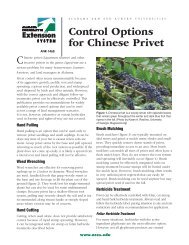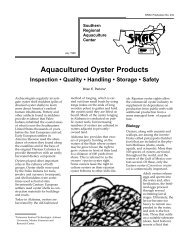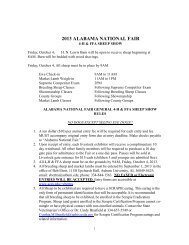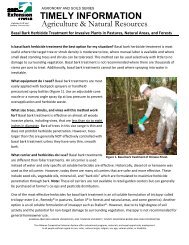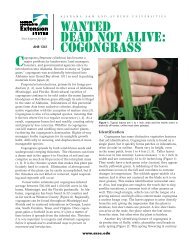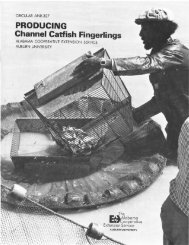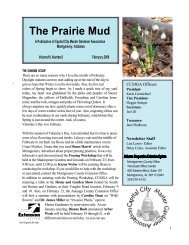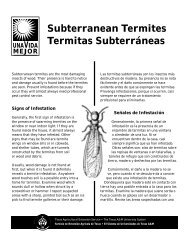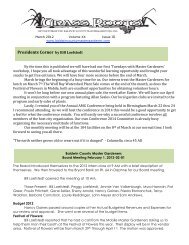Cage Culture: Species Suitable for Cage Culture - SRAC Fact Sheets
Cage Culture: Species Suitable for Cage Culture - SRAC Fact Sheets
Cage Culture: Species Suitable for Cage Culture - SRAC Fact Sheets
Create successful ePaper yourself
Turn your PDF publications into a flip-book with our unique Google optimized e-Paper software.
at temperatures above 80oF may<br />
adversely stress the fish and lead<br />
to disease and possibly death.<br />
Stocking poor quality fingerlings<br />
be<strong>for</strong>e the water reaches 60oF (when predictable feeding occurs)<br />
can lead to handling stress compounded<br />
by nutritional stress<br />
from the lack of food intake. For<br />
these reasons it is probably best to<br />
stock when water temperatures<br />
are between 60 and 70oF. Of<br />
course, fish farmers may have to<br />
learn how to handle and stock<br />
fingerlings at any range of temperatures<br />
to be competitive and<br />
meet their marketing objectives.<br />
Size of catfish fingerlings to be<br />
stocked depends on the length of<br />
growing season, availability, and<br />
marketing strategy. The minimum<br />
size fingerling which can be<br />
stocked into a cage made of 1 /2inch<br />
mesh is approximately 5<br />
inches. Generally 6- to 8-inch fingerlings<br />
are stocked into cages. If<br />
a 1 1 /4- to 1 1 /2-pound fish is the<br />
desired market size at harvest it<br />
may be necessary to stock a larger<br />
fingerling or stock at a lower<br />
stocking rate. A larger fingerling<br />
must be stocked in the northern<br />
part of the southeastern region (or<br />
at high elevations) where the<br />
growing season is shorter. It is not<br />
uncommon to stock 8- to 10-inch<br />
fingerlings where the growing<br />
season is 180 days or less.<br />
Availability and cost of larger fingerlings<br />
may make stocking these<br />
sizes prohibitive. A fingerling<br />
over 10 inches in length may not<br />
adapt well to a cage.<br />
Uni<strong>for</strong>mity of fingerling size is<br />
also important. Research has<br />
shown that catfish fingerlings of<br />
uni<strong>for</strong>m size (all within 1 /2 inch<br />
of the same length) will grow<br />
more homogeneously, reaching a<br />
larger average size and increasing<br />
total cage production over fingerlings<br />
with a 1 inch or longer variation<br />
in length.<br />
The strain or variety of channel<br />
catfish stocked into cages can<br />
make a great difference in production<br />
or yield. Different strains<br />
have been developed or selected<br />
at both public and private hatch-<br />
eries throughout the Southeast.<br />
Not all of these strains do equally<br />
well in cages even though they<br />
may grow well in open ponds. In<br />
fact, strain research in cages suggest<br />
that some strains can grow as<br />
much as 50 percent faster than<br />
other strains. There<strong>for</strong>e, probably<br />
the best general advice is to talk to<br />
other cage producers in your area<br />
and ask which fingerling source<br />
they like and have been successful<br />
with. Research done at Auburn<br />
University has shown that strains<br />
with a Kansas or Marion (named<br />
after the Federal hatcheries)<br />
ancestry do well in cage conditions.<br />
This same research has<br />
shown that many private hatcheries,<br />
but certainly not all, have<br />
channel catfish strains that grow<br />
well in cages. Ask other cage producers<br />
and use a strain that has a<br />
good reputation.<br />
Stocking densities <strong>for</strong> catfish fingerlings<br />
in cages range from 5 to<br />
14 per cubic foot of cage. This<br />
equates to 250 to 600 fish in a 4 x 4<br />
feet cylindrical cage. Generally<br />
speaking it is best to stock at the<br />
low densities (5 to 8 per cubic<br />
foot) when first attempting cage<br />
culture, particularly if supplemental<br />
aeration is not present. Do not<br />
stock below a density of 5 per<br />
cubic foot or catfish may fight,<br />
leading to injury and disease.<br />
Some recommended stocking<br />
rates <strong>for</strong> small cages are given in<br />
Table 1. Even with supplemental<br />
aeration available it may be<br />
advantageous, <strong>for</strong> stress reasons,<br />
to stock additional cages rather<br />
than overstock individual cages.<br />
Overstocking can reduce growth<br />
and increase disease problems.<br />
Table 1. Recommended stocking<br />
rates <strong>for</strong> cages.<br />
Stocking<br />
<strong>Cage</strong> Size Rates<br />
4 x 4 feet (round) 250 - 400<br />
4 x 4 x 4 feet 320 - 500<br />
8 x 4 x 4 feet 640 - 1,000<br />
8 x 8 x 4 feet 1,280 - 2,000<br />
6 x 12 x 4 feet 1,500 - 2,300<br />
2<br />
Blue catfish, hybrid catfish (blue<br />
catfish male x channel catfish<br />
female), and bullhead catfish have<br />
been stocked in cages with limited<br />
success. Blue and hybrid catfish<br />
do not grow as well in cages as<br />
channel catfish. Bullhead catfish<br />
have been raised in cages and<br />
appear to do relatively well.<br />
Recommended stocking size is a<br />
6-inch fingerling. Bullheads do<br />
not grow as large as channel catfish,<br />
however, and are expected to<br />
get to only 1 /2 pound in a growing<br />
season. Bullhead fingerlings<br />
are generally difficult to find and<br />
may be expensive.<br />
Trout<br />
Rainbow, brown, and brook trout<br />
can all be reared in cages.<br />
Rainbow trout are most often cultured<br />
because of the availability of<br />
fingerlings, established market,<br />
and adaptability to cages. Basic<br />
culture of all three species is similar.<br />
Rainbow trout will be<br />
described here, but the in<strong>for</strong>mation<br />
should apply to other trout<br />
species.<br />
Rainbow trout<br />
Trout are coldwater species.<br />
Optimum growth temperature <strong>for</strong><br />
trout is between 55 and 65 o F, but<br />
good growth is attained between<br />
50 and 68 o F. At 70 o F severe heat<br />
stress begins, usually followed by<br />
death if exposure is prolonged.<br />
Below 45 o F feed conversion drops<br />
significantly and, there<strong>for</strong>e,<br />
growth. These temperature<br />
regimes make cage culture of<br />
trout a wintertime only activity in<br />
most of the southeastern United<br />
States, except where cold spring<br />
water or high altitude lowers<br />
summertime water temperatures.



